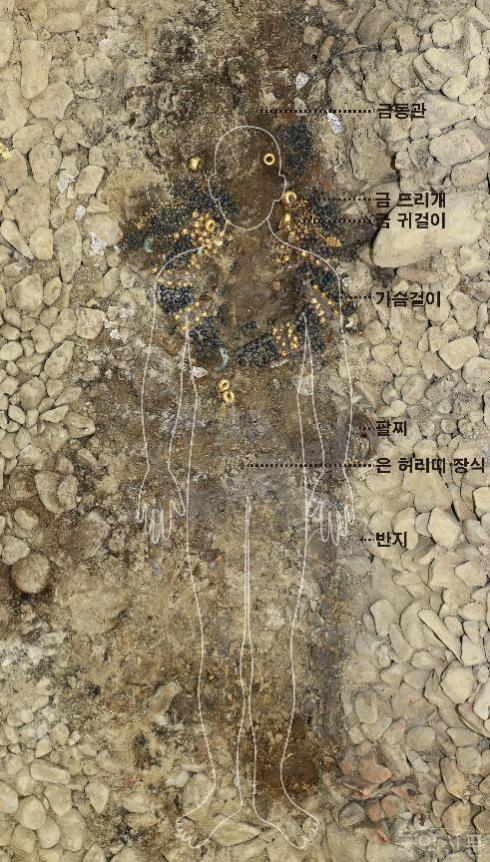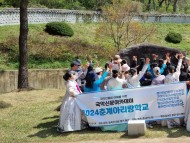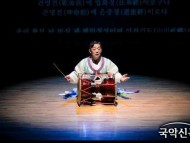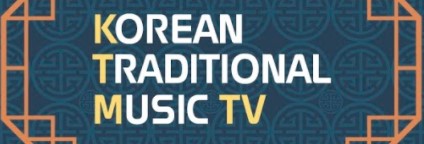2024.04.20 (토)
Luxurious Ornaments of Silla Women with 200 Pieces of Baduk Stones at Tomb no. 44 in Jjoksaem, Gyeongju
- Michael Lammbra…
- 등록 2020.12.08 19:29
- 조회수 356

Luxurious Ornaments of Silla Women with 200 Pieces of Baduk Stones at Tomb no. 44 in Jjoksaem, Gyeongju
- To Identify Gilt-Bronze Ornaments with Golden-Edge Jewel Beetles and a Stone Mortar and Pestle/ Online Presentation at 4pm on 7th December-
The Gyeongju National Research Institute of Cultural Heritage (GNRICH_Director Lee Jong-Hoon) has carefully excavated theSillaancient tomb no. 44* at Jjoksaem in Gyeongju since 2014. Last month, the GNRICH discovered various ornaments, which tomb owner wore, including a gilt-bronze crown, a pair of gold pendants, a pair of gold earrings, a chest ornament, 12 pieces of gold and silver bracelets, 10pieces of gold and silver rings, a silver belt ornament, gilt-bronze ornaments decorated with golden-edge jewel beetles, a stone mortar and a pestle and 200 pieces of baduk stones and 50 pieces of mica* through this close excavation research.
*Excavation area: 349-3, Seongdong-dong, Gyeongju-si, the Jjoksaem Housed-Excavation Site.
**Mica: Mica is one of the silicate minerals. It was believed as a medicine for perpetual youth and longevity in Taoism.
Styles of the ornament assemblages, worn by the owner of the Silla stone-piledwooden chamber tomb no. 44, are a typical type that could be found in the wooden chamber tombs. In particular, the chest ornament was woven in 4 rows of gold and silver beads with indigo glass beads and Dalgae*. Such style was a design that onlyfound in the upper-class tombs such as Hwangnamdaechong (Great Tomb of Hwangnam) and Cheonmachong (Tomb of the Heavenly Horse).
* Dalgae: thinmetal adornments dangle from crowns to twinkle.
To consider assemblages and materials of adornments, the owner of the Silla stone-piledwooden chamber tomb no. 44 could be presumed as a royal family. In addition, there is a high possibility that the person could be female as she carries a knife with silver decoration rather than an adorned dagger (裝飾大刀). Based on excavated artifacts, the height of the buried person is estimated to be about 150cm. Overall small size of ornaments, including a gilt-bronze crown, earrings, bracelets and pendants for a belt, proves that the buried person is a woman. The small size of adornments is similar to Geomryeongchong (Tomb of the Golden Bell) among the previous investigations.
Although it is hard to identify exact pattern and shape of the gilt-bronze crown and silver belt adornment at the moment, it will be identified through preservation research later. The construction date of the Silla stone-piled wooden chamber tomb no. 44 is assumed to be in the late 5th century considering the similarity with excavated earthenware, styles of gold earrings and bracelets from Geomgwanchong (Tomb of the Golden Crown).
Another remarkable artifact is the decorations of golden-edge jewel beetles. Dozens of decorations of golden-edge jewel beetles were found in the upper part of a chest for grave goods, placed at the head of a buried person. Two wings of golden-edge jewel beetles overlaid to form a water drop and were fixed by a gilt-bronze panel in its front and back. Its size is 1.6x3.0cm in width and length and 2mm in thickness. The form and size of the accessories have not been found in any Silla ancient tomb thus far.
The ornaments of golden-edge jewel beetles at tomb no. 44 lead to assume the status of the buried person. It is because that the decorations golden-edge jewel beetles had been discovered only from tombs of the highest ranks in Silla, such as the south tomb of Hwangnamdaechong, Geomgwanchong and the Tomb no. 14 in Gyerim-ro. Furthermore, all the adornments of the golden-edge jewel beetles from the Silla ancient tombs were all horse gears thus far. Because of that, these ornaments from the tomb no. 44 could be used to hang on saddlesor saddle flaps.
A stone mortar and a pestle were identified together right next to the iron pot inside of the chest at the buried person’s head. The stone mortar has a flat bottomin a rectangular shape. It was made of granite and polished to make a shallow hollow in the top. Based on its size (height 13.5cm, width 11.5cm) and capacity of its hollow (about 60ml), the mortar is estimated to be buried for a symbolic meaning or used as a mortar for medicine rather than a practical mortar for wheats.
Up to date, there were cases to find mortars and pestles from the Silla ancient tombs; a set from the south tomb of Hwangnamdaechong and a pestle from Seobongchong (Tomb of Auspicious Phoenix). Although the find location is not clear, there is a mortar and pestle setin donated artifacts by Dr. Kukeun Lee Yangseon (1916~1999).
200 pieces of baduk stones were excavated between earthenware under the feet of the buried person. The size is about 1~2cm in diameter and 0.5cm in thickness and most of them were 1.5cm in diameter in colors black, white and gray. It is presumed that baduk stones were collected in nature and used as it was because there were no traces of artificial process. In the past, baduk stones of the Silla era were unearthed in tombs of the highest class, such as 243 pieces from the south tomb of Hwangnamdaechong, 350 pieces from Cheonmachong, 200 pieces from Geomgwanchong and 2 pieces from Seobongchong. After this period, 170 pieces of baduk stones were found in the 7th century’s stone chamber tomb no.6 with tunnel entrances in Yonggang-dong and a baduk-board-shaped stone with engraved 15rows vertically and horizontally were discovered at Bunhwangsa Temple site.
According to King Hyoseong parts (reigned. 737-742) in the Samguksagi (history of the Three Kingdoms) and Samgukyusa (memorabilia of the Three Kingdoms), there were records that the King Hyoseong played baduk and the Silla peopleplayed baduk well. These baduk stones could provide the actual supporting data about baduk culture in Silla. Hitherto, tomb owners where baduk stones were excavated were all assumed to be male. Hence, it was predicted that baduk was the exclusive property of men. As the tomb owner at this time is presumed to be female,it is expected to give new interpretation and meaning to the baduk culture.
This excavation on the Silla ancient tomb no. 44 at Jjoksaem area in Gyeongju, which has been conducted since 2014, has been in its 7th years this year. Currently, the excavation has been exposed artifacts from the buried person. In addition, ritual traces performed around stone protection for the tomb, burial methods, structure and construction methods of piling stone and ritual acts at various spots have been identified. Through this, various supporting materials are ensured to restore the structure of the medium and large stone-piled-wooden chamber tombs and its construction methods. Moreover, these unearthed artifacts lead to understand the burial culture of the Silla’s highest ruling society at that time.
In the future investigation, the GNRICH will closely research and analyze various artifacts excavated in layers. The GNRICH will also restore the structure and construction process of the entire tomb through dismantling investigation of the tomb’s substructure, stone protection and piled stone part. Furthermore, the GNRICH will conduct thorough and interdisciplinary researches on the stone-piledwooden chamber tomb no. 44 at Jjoksaem area in Gyeongju based on the co-operation with domestic and overseas research institutes.
The Gyeongju National Research Institute of Cultural Heritage, under the Cultural Heritage Administration, strives to make an excavation research that communicates with the people through the real-time sharing of the excavation process, regular report of research results, on-site presentation to the public and various experience programs. The result of this excavation research on tomb no. 44 will be held to present at 4pm on the 7th of December through the GNRICH YouTube channel. From the YouTube, online presentation and question-and-answer session will be in real-time to communicate with the public.
The GNRICH YouTube channel:
https://www.youtube.com/channel/UCyvYCBA2aJFa8hIdIpur82Q
- [] 제32회 전국청소년민속예술경연대회(05/18)
- [] 제42회 전주대사습놀이 학생전국대회(5/18∼6/2)
- [] 제50회 전주대사습놀이 전국대회(5/18~6/3)
- [] 제4회 함양 전국국악경연대회(05/12)
- [] 제18회 대한민국 전통예술무용·연희대제전(06/09)<br>무용(전통무용…
- [] 제48회 부산동래 전국전통예술경연대회(06/15-16)(무용.기악)
- [] 제1회충남전국청소년국악경연대회(05/04)(판소리.기악.타악)
- [] <br>[광주]제21회 대한민국 가야금병창대제전(06/16)
- [] 제18회 과천전국경기소리경창대회(05/04)
- 제11회곡성 통일전국종합예술대전(06/15-16)
- [] 제24회 인천국악대제전 전국국악경연대회(05/25-26)
- [] 제26회 창원야철전국국악대전(07/06- 07)
- [] 2024 무안장애인 승달국악대제전(06/01-02)
- [] 제22회 무안전국승달국악대제전(06/01-02)
- [] 제10회 전국공주아리랑민요경창대회(05/26)
- [] 제17회 상주전국국악경연대회(05/19)(성악/무용·연희/기악)
- [] 제10회 전국밀양아리랑경창대회(05/26)
- [] 제21회 강남전국국악경연대회(05/22)(무용/타악/판소리/민요)
- [] 제26회 서편제보성소리축제 전국판소리 고수 경연대회(05/04-05)
- [] [순천]제10회 낙안읍성 전국 국악대전(04/27-28)
- [] 제29회 안산전국청소년국악경연대회(05/26)
- [] 제26회(통합58회) 여수진남전국국악경연대회(05/18-19)
- [] 제51회 대한민국 춘향국악대전 경연대회(05/05)(05/11-12)
- [] 제33회 고령전국우륵가야금경연대회(04/26-27)
- [] [부평]제8회 전국 청소년국악경연대회(05/11)(관악/현악/성악)
- [] 제22회 구례전국가야금경연대회(05/04-05)
- [완도]제24회 장보고국악대전 전국경연대회(05/05-06)(무용/판소리…
- [] 제4회 금천정조대왕맞이전국청소년국악경연대회(04/13-14)
- [] [세종시]제10회 통일기원 세종전국국악경연대회(04/06-07)
-

[금요연재] 도자의 여로(141)<br>분청상감대호편
작지만 문양이 이채로워 이규진(편고재 주인) 명품 청자를 생산했던 강진과 부안이 쇠퇴한 원인으로는 여러 가지를 들 수 있다. 그 중에는 고려 말의 혼란한 정국이라든...
-

[수요연재] 한글서예로 읽는 우리음악 사설(188)<br>원주어리랑, 산은 멀고 골은…
원주어리랑을 쓰다. 한얼이종선 (2024, 문양지에 먹, 34 × 34cm) 어리랑 어리랑 어러리요 어리랑 고개로 넘어간다. ...
-

[수요연재] 이무성 화백의 춤새(87)<br> 정인삼 명인의 '신칼대신무' 춤사위
신칼대신무 신칼대신무는 무속장단과 巫具를 활용한 재인의 춤으로, 장단과 움직임의 법도 있는 만남을 잘 보여주는 춤이다. 구한말 화성재인청에서 가르친 50여 가지의...
-

[화요연재] 무세중과 전위예술(9) <BR>김세중의 한국민속가면무극 춤사위 발표회19…
멍석 위에서 민속극에 뜻을 둔 이래 가장 절실했던 것은 둔한 몸을 가지고 직접 춤을 익혀야 한다는 것이다. 우리들 생활의 분신의 하나인 전통 민속극과 좀처럼 사귀어...
-

[월요연재] 이윤선의 남도문화 기행(140)<br>잔인한 적군의 시신까지 거든 바다의…
왜덕산(倭德山)의 비밀 피아를 나누지 않고 위령 바다사람들 심성 깃들어 왜군에도 그러해야 했던 섬과 바다의 민속 관념은 인류의 박애 정신 아닐까 교착상태 빠진 한·일 문...
-

[수요연재] 한글서예로 읽는 우리음악 사설(188)
갑진년 사월에 강원도 아리랑을 쓰다 오거서루주인 이종선 (2024, 한지에 먹,48 × 56cm) ...
-

[Pick리뷰] 이 시대의 새로운 춘향가- ‘틂:Lost&Found’
2024 쿼드초이스_틂 (사진=서울문화재단 대학로극장 쿼드 나승렬) [국악신문 정수현 전문기자]=대학로극장 쿼드의 ‘쿼드초이스’...
-

[Pick리뷰] 세 악단의 조화로운 하모니, ‘하나 되어’
지난 4일, 국립국악원은 국립국악원 창작악단, KBS국악관현악단, 전북특별자치도립국악원 관현악단 118명으로 구성된 연합 관현악단 무대 ‘하나되어’를 국...
-

[인터뷰] 김경혜의 '시간의 얼굴' 작품전, 16일 개막
칠순을 넘어서는 길목에서 중견작가 김경혜(영남이공대 명예교수) 작가의 열번째 작품전이 오는 16일부터 25일까지 10일간 대구시 중구 슈바빙 갤러리에서 열린다.전시되는총 50여 개...
-

[Pick리뷰] 국립국악관현악단의 관현악시리즈 III ‘한국의 숨결’
국립국악관현악단의 관현악시리즈 III ‘한국의 숨결’이 KBS국악관현악단 상임지휘자 박상후의 지휘로 국립극장 해오름극장에서 펼쳐졌다. (사진=국립국악관현악단...
-

[PICK인터뷰] 국악인생 60여년, 한상일 대구시립국악단 예술감독
한상일(1955~) 대구시립국악단 예술감독 및 상임지휘자는 국악에 입문한 지 올해로 60여 년을 맞는다. 때 맞춰 지난 1월 25일 서울문화투데이 신문에서 선정하는 제15회 문화대...
-

[Pick리뷰] 명연주자 시리즈 ‘국악관현악-공존(共存)’
[국악신문 정수현 전문기자]=지난 3월 22일, 세종문화회관 M씨어터에서 서울시국악관현악단 2024 명연주자 시리즈 ‘공존(共存)’ 무대가 펼쳐졌다. ‘명연주자 시리...
-

[Pick리뷰] 소리극 ‘두아-유월의 눈’
[국악신문 정수현 전문기자]=지난 12일부터 22일, 국립정동극장은 대표 기획공연 사업 ’창작ing’의 두 번째 작품, 소리극 ‘두아:유월의 눈’을 무대에 올렸다. ‘두아:...
-

한류의 의외의 원류? ‘일본아리랑’에 놀라
한국을 대표하는 음곡 ‘아리랑’. "아리랑 아리랑 아라리요 아리랑 고개를 넘어간다...”라는 노래다. 각종 스포츠 대회나 정상회담 만찬회 등 공식 행사에서는 어김없이 연주되...
-

[인터뷰] 이즘한글서예가전 신인작가 이광호 작가의 시선
봄바람을 타고 13일 인사동 한국미술관에서 개최되는 네번째이즘한글서예가전에서 출품한 30명의 작가 중 가장 젊은 신인작가라고 한얼 회장이 소개를 한 3분의 작가 중 이광호(43세)...
-

[Pick리뷰] 전통 탄탄한 국악관현악: ‘작곡가 이강덕
[국악신문 정수현 전문기자] =국립국악원 창작악단은 지난 7~8일 기획공연 ‘작곡가 시리즈 Ⅲ’을 선보였다. 작곡가 시리즈는 창작국악의 토대가 된 작곡가를 선정해 의미를 되...






























